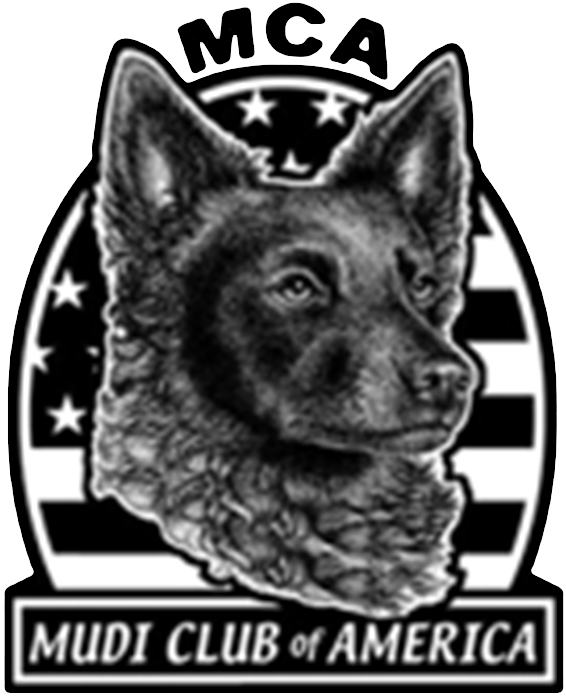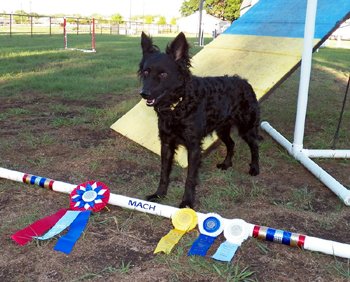
About The Breed
Melting Pot
For many ages, the country of Hungary, situated in the heart of Europe, was the melting pot of Huns, Slavs, Teutons and Turks who lived together in this part of central Europe. During the so-called Great Migration - between the fourth and the sixth centuries - different types of dogs arrived on the Great Hungarian Plain of the Carpathian Mountains. The majority were sheepdogs kept by herdsmen who travelled with their flock and originated in Asia Minor. The Magyars (the original name of the Hungarian people) kept sheepdogs from the end of the ninth century, but pedigree breeding and classification of dogs only started in the second half of the 19th century. Before that time, Hungarian sheepdogs were simply divided into two categories: large and small. When breeding, the small dogs were divided from the big ones (Kuvasz, Komondor), but the small ones were interbred. Therefore, the early history of the Mudi is more or less the same as those of the Pumi and the Puli.
‘Third type’ sheepdog
Count István Széchenyi (1791-1860) was the founder of the Hungarian Academy of Science and The Pest County Greyhound Society, and one of the first promoters of Hungarian dog breeds. Another important man in the history of Hungarian dogs is Dr. Emil Raitsits, a professor at the Veterinary Clinic in the city of Budapest. In the early 20th century, Dr. Raitsits travelled around the country looking for good examples of Hungarian sheepdogs, but seemed more interested in Pulis and Pumis than in the so-called ‘third type’, the Mudi. Nevertheless the Mudi is probably the oldest of the Hungarian sheepdogs, although ‘the great unknown’. This ‘third type’ of small sheepdogs was and is known in almost the whole of Hungary. It is said that in ancient times this little sheepdog could be found in the lowlands of Pannonia, now parts of Hungary, Austria and former Yugoslavia. Some others believe that he came from crossings between the Puli and the Pumi. And last but not least it is believed that he has derived from crossings between local sheepdogs and the Alsatian or German Spitz. It’s unverifiable, of course, but the last explanation is tempting, especially considering the shape of the head and the expression of the eyes.
“AN OLD AND RARE HERDING BREED FROM HUNGARY”Canis ovilis Fényesi
Around 1930, a certain Dr. Deszö Fényesi, director of the museum in Balassagyarmat, was one of the first breeders to become involved in separate breeding of this small sheepdog. He is also the one who named the breed Mudi. Why Mudi? Unfortunately, I have never found a good explanation for this name. (The breed’s name in Latin is Canis ovilis Fényesi.) A new breed standard was written by Dr. Zoltan Balassy in 1966 to apply for FCI recognition. This standard was based on only a handful of Mudi’s and the main differences between the original standard were accepted sizes and colors. The F.C.I. approved the breed standard in 1966, but very few people were involved in breeding then and this is still the case today. A new standard was written in 2000 and the present FCI breed standard dates from 2004.As there were 80 years ago, there are many different types in the Mudi; they form a heterogeneous company, resembling the Spitz dogs in head and the Croatian sheepdog in body. The Mudi is a real working dog - a farmer’s dog - even more so than the Pumi or the Puli. Today, most of them live on the farms in Hungary and very often the litters are not registered. The Mudi is multi-functional - he drives the flock, guards the house and is an extremely good exterminator of small vermin. He is an expert with ‘difficult’ cattle and has also proven to be a good tracking dog. It is a blessing for this young breed that there is no separation between working lines and show lines. Since the ‘70s, a small number have been exported, especially to Sweden and Finland. There are about 70 Mudis in The Netherlands, and worldwide their number is about 1,500-1,750.
A Curly-coated Small Spitz
The distinction between the Mudi and the Puli and Pumi is relatively small, but there are various significant differences. First of all, the eyes are oval, dark and set obliquely, while the eyes of the Puli and Pumi are roundish. His ears are pricked, like those of a Spitz. The coat is not corded like the Puli’s, but short or half-long and curly. Sometimes Mudis are born without a tail, or with a natural stump tail; this is not regarded as a fault. In general, the Mudi gives the impression of a curly-coated small Spitz. He is not as boisterous as the Pumi and that makes him appreciated as a companion dog in the house. Still, the Mudi is not a dog for beginners. He needs a firm hand and a lot of exercise, especially if there is no real work to do. In Sweden and Finland, Mudis are used as tracking dogs, rescue dogs, for agility, and driving sheep. In Hungary, these dogs are organized in the Hungarian Puli-Pumi-Mudi Club. A second breed club is named after the man who was the founder of the modern breed: the Dezsö Fényes Mudi Club. Today there are several breed clubs outside Hungary, for example in the Czech Republic, Finland, Sweden and Canada. The Mudi Club of America was founded in 2004 and “strives to promote, protect, and preserve the Mudi as a healthy versatile working breed, of sound temperament, and proper breed type, while educating fanciers on responsible Mudi ownership.”
Credit goes to the "Canine Chronicles" for the following article:
Text by RIA HÖRTER
[Original Source]
FAQ
What in the heck is a Mudi? What is the general Mudi temperament? Are Mudi's easy to train? Is the Mudi a good house dog? Are Mudi's good with children? Are Mudi's noisy? Does their coat require a lot of maintenance? Does the Mudi shed? How many different colors are there? How large will a Mudi grow? How long will a Mudi live? Does the Mudi have any health problems? How much exercise does a Mudi need? Does the AKC recognize this breed? Where can I show my Mudi? Is the Mudi for me?

